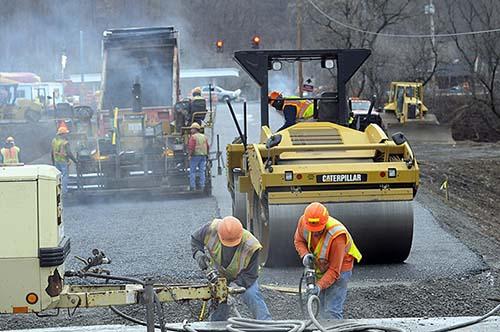Introduction
Have you ever driven past a road construction site and found yourself engulfed in a cloud of thick, pungent fumes? This exact concern was recently raised by a curious individual who wondered about the safety of those fumes. As he navigated through the maze of orange cones and heavy machinery, he couldn’t help but question what those fumes were made of and whether they posed any risk to his health or the workers toiling under the hot sun.
It’s a question that many of us have pondered but rarely investigated. What are those fumes, and are they indeed safe? The truth is, the tar and asphalt fumes emitted during road construction contain substances that can be harmful to both short-term bystanders and the workers who are exposed to them daily. The smell that often accompanies new road construction isn’t just a fleeting inconvenience; it’s a sign of a complex mixture that can have serious health implications. This article delves into the hidden dangers of tar and asphalt fumes, offering insights into their effects on health and the necessary precautions to mitigate risks.
Short-Term Exposure and Its Effects
Short-term exposure to asphalt fumes can cause immediate discomfort and health risks. Symptoms may include:
Irritation of the Eyes, Nose, and Throat: Exposure to fumes can cause watering eyes, nasal congestion, and throat irritation, leading to coughing.
Respiratory Issues: Inhalation of the fumes can lead to wheezing, shortness of breath, and irritation in the lungs.
Skin Irritation: Direct contact with tar or asphalt may result in skin redness, itching, and even burns.
Long-Term Effects of Exposure
The dangers of prolonged exposure to asphalt fumes are more alarming:
Chronic Respiratory Illnesses: This includes bronchitis and emphysema, resulting from continuous inhalation of harmful fumes.
Cancer Risks: Polycyclic aromatic hydrocarbons (PAHs), emitted from tar bitumens, are linked with some types of cancers.
Concentration of PAHs in Air Samples: A study conducted at 11 road work sites revealed that 4.8% of air samples contained PAHs greater than 2 µg/m³, with a peak of 17.8 µg/m³.
Temperature-Related Risks: The risk multiplies when the tar bitumen’s temperature ranges between 135 and 150 degrees Celsius.
Safety Measures and Precautions
To mitigate these risks, adopting proper safety guidelines is crucial.
Personal Protective Equipment (PPE): Workers should wear coveralls, safety glasses or face shields, and respiratory protection.
Open-Air Spaces: Handling asphalt in well-ventilated areas or open-air spaces helps reduce the concentration of fumes.
Education and Training: Workers must be aware of the potential risks and trained in safety procedures to minimize exposure.
Conclusion
Regulatory Environment
In the United States, there are currently no specific Occupational Safety and Health Administration (OSHA) standards for asphalt fumes. However, exposures to various chemical components of asphalt fumes are addressed in specific standards for the general and construction industries, such as personal protective equipment (PPE)
Although OSHA has not set a legal standard for workplace asphalt fume exposure, a 1992 OSHA proposal to establish a 5.0 mg/m³ limit to protect against irritation effects is pending.
In California, Cal/OSHA’s permissible exposure level (PEL) for asphalt fumes is 5 mg/m³.
Some asphalt additives may also have their own PEL limits, so it is important to check the product’s Safety Data Sheet (SDS) for additional information
California Code of Regulations, Title 8, Section 1528, addresses the control of harmful dusts, fumes, mists, vapors, or gases in the workplace, requiring employers to implement engineering controls, limit daily exposure, or remove employees from exposure to hazards
To minimize the risk of exposure to asphalt fumes, workers should follow safety guidelines and use proper protective equipment, such as coveralls, safety glasses or face shields, and respiratory protection. It is also recommended to handle asphalt in open-air spaces or well-ventilated areas to reduce the concentration of fumes.
Conclusion
The development and maintenance of road networks are essential for modern society. Yet, the risks associated with tar and asphalt fumes should not be overlooked. Implementing stringent safety guidelines and protective measures can significantly reduce these risks. Workers and employers must collaborate to create a safe working environment, prioritizing health without compromising progress.
References:
- https://www.nj.gov/health/eoh/rtkweb/documents/fs/0170.pdf
- https://int-enviroguard.com/blog/working-with-asphalt-hazards-and-safety-measures/
- https://pubmed.ncbi.nlm.nih.gov/2920140/
- https://www.dugan-associates.com/the-dangers-of-asphalt-fumes/
- https://www.safeatworkca.com/safety-articles/working-with-asphalt/
- https://www.latesting.com/News.aspx?newsid=836
- https://www.dir.ca.gov/title8/1528.html
- https://www.owenscorning.com/Trumbull/technical-support/published-papers/healtheffects.pdf
- https://www.osha.gov/asphalt-fumes/standards
- Image Reference










